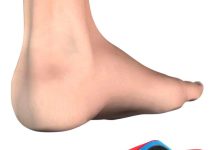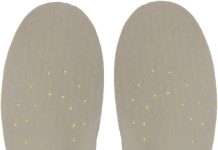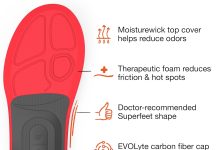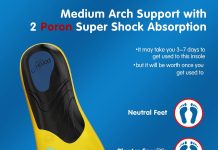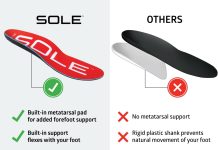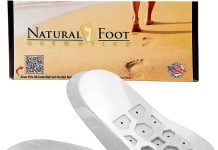Having flat feet can be a source of discomfort and pain, but you might be wondering if there is a solution. Look no further than orthotic insoles! These specially designed inserts can provide the support and alignment your feet need, ultimately helping to alleviate the symptoms of flat feet. Whether you’re experiencing arch pain or struggling with foot fatigue, orthotic insoles could be just the remedy you’ve been searching for. But do they really work? Keep reading to find out.
What are flat feet?
Flat feet, also known as fallen arches, is a common condition characterized by the absence or low arches in the foot’s inner sole. Instead of the foot’s arch being curved slightly off the ground, the entire sole comes into contact with the surface. Flat feet can be bilateral, meaning it affects both feet, or unilateral, affecting only one foot. This condition can occur in both children and adults and may be present from birth or develop over time.
Causes of flat feet
Genetics
One of the most common causes of flat feet is genetics. If either of your parents or other close relatives has flat feet, you may be more likely to develop the condition. This is because the structure of the foot is inherited, and certain genes can influence the development of arches. However, it’s important to note that not everyone with a genetic predisposition will develop flat feet.
Foot injury
In some cases, flat feet can be the result of a foot injury. Trauma to the foot, such as fractures or ligament damage, can weaken the arch and cause it to collapse. Additionally, conditions like tendonitis or arthritis can also contribute to the development of flat feet. It’s crucial to seek medical attention if you suspect your flat feet are the result of an injury or underlying medical condition.
Weak arches
Weak arches, also known as flexible flat feet, can be another cause of the condition. This occurs when the arch appears normal when not bearing weight, but flattens when standing or walking. Weak arches can be caused by muscle imbalances or tightness, leading to the collapse of the arches. This type of flat feet often runs in families and can be exacerbated by factors like obesity or excessive pronation.
Symptoms of flat feet
Flat feet can present with a range of symptoms, which vary from person to person. Some common symptoms include:
- Pain or tenderness along the inner side of the foot
- Swelling on the inside of the ankle
- Foot fatigue or aching after prolonged standing or walking
- Difficulty fitting into shoes, especially ones with arch support
- Uneven wearing of shoes, particularly on the inside of the sole
If you are experiencing any of these symptoms, it is advisable to consult with a healthcare professional for a proper diagnosis and appropriate treatment.
Effects of flat feet on the body
Flat feet can have significant effects on the body beyond the feet themselves. Here are some common effects flat feet can have on other body parts:
Foot pain
Flat feet can lead to pain in the feet due to the increased stress and strain placed on the ligaments, tendons, and muscles. This pain can be present in the arch area, heel, or the entire foot. Over time, the misalignment caused by flat feet can result in conditions such as plantar fasciitis, bunions, or shin splints.
Knee and hip problems
The lack of proper arch support in flat feet can cause alignment issues in the lower extremities, which can affect the knees and hips. Without the natural shock absorption provided by the arches, the joints in the knees and hips can be subjected to excessive stress, leading to pain, inflammation, and a higher risk of developing conditions such as arthritis or bursitis.
Back pain
The misalignment caused by flat feet can have a cascading effect on the entire body, including the spine. When the feet are not properly aligned, it can alter the body’s center of gravity, leading to imbalances and compensations in posture. This can put strain on the back muscles, leading to chronic back pain, stiffness, or even herniated discs.
Understanding orthotic insoles
Definition
Orthotic insoles, also known as orthotic inserts or shoe inserts, are devices designed to provide additional support and stability to the feet. These insoles are placed inside the shoes to correct biomechanical imbalances, improve foot alignment, and alleviate the symptoms associated with conditions like flat feet.
Types of orthotic insoles
There are two main types of orthotic insoles: custom-made and over-the-counter (OTC). Custom-made insoles are individually crafted to suit the specific needs and foot structure of the individual. These insoles are often prescribed by healthcare professionals and are made from precise measurements and molds of the individual’s feet. On the other hand, OTC insoles are readily available without a prescription and are designed to address common foot ailments and provide general support. While OTC insoles may offer some benefits, they may not provide the same level of customization and precision as custom-made insoles.
How do orthotic insoles work?
Orthotic insoles work by addressing the underlying biomechanical issues associated with flat feet. Here are some ways in which they provide support and improve foot function:
Providing arch support
One of the primary functions of orthotic insoles is to provide additional support to the arches of the feet. By lifting and supporting the arch area, these insoles help to redistribute the weight and relieve pressure on the foot’s ligaments and muscles. This can help to reduce pain and discomfort associated with flat feet.
Improving foot alignment
Orthotic insoles are designed to promote proper foot alignment by correcting any imbalances or abnormalities in the foot structure. They can help to realign the foot and ankle, ensuring better alignment of the knees, hips, and spine. By improving overall foot alignment, orthotic insoles can help reduce the strain on the joints and other structures in the lower extremities.
Distributing pressure evenly
Flat feet can cause certain areas of the foot to bear more weight than others, leading to excessive pressure and potential injury. Orthotic insoles help distribute the pressure evenly across the entire foot, reducing the strain on specific areas and preventing overloading of certain structures. This can help prevent the development of foot conditions such as calluses, corns, or ulcers.
Benefits of using orthotic insoles for flat feet
Pain relief
One of the significant benefits of using orthotic insoles for flat feet is the potential for pain relief. By providing additional support and improving foot alignment, these insoles can alleviate the pain and discomfort associated with flat feet. They can help reduce the strain on the ligaments, tendons, and muscles, allowing for improved comfort during weight-bearing activities.
Improved posture
The misalignment caused by flat feet can negatively impact overall posture. By correcting foot alignment, orthotic insoles can help improve posture throughout the entire body. Proper alignment of the feet, knees, hips, and spine can contribute to better overall body mechanics and reduce the risk of developing postural issues or related pain.
Reduced risk of complications
Addressing flat feet with orthotic insoles can help reduce the risk of developing complications and further foot problems. By providing adequate support and aligning the feet correctly, these insoles can prevent excessive stress and strain on the ligaments, tendons, and joints. This, in turn, can minimize the risk of conditions such as plantar fasciitis, tendinitis, or degenerative joint diseases.
Choosing the right orthotic insoles
When it comes to choosing orthotic insoles for flat feet, it is important to seek guidance from a healthcare professional. They can assess your specific needs, foot structure, and gait pattern to determine the most appropriate type of insole for you. Some factors to consider when choosing orthotic insoles include:
Consulting a healthcare professional
If you suspect you have flat feet or are experiencing foot pain, it is advisable to seek professional advice. A podiatrist or orthopedic specialist can evaluate your condition, identify any underlying issues, and recommend the most suitable orthotic insoles for your specific needs. They can also provide guidance on proper fitting and usage.
Custom-made vs. over-the-counter insoles
The choice between custom-made and over-the-counter insoles depends on the severity of your flat feet and individual preferences. Custom-made insoles offer a higher level of customization and are recommended for individuals with severe or complex foot conditions. These insoles provide precise support tailored to your individual foot shape and biomechanics. On the other hand, over-the-counter insoles are more readily accessible and can provide relief for milder cases of flat feet. While they may not offer the same level of customization, they can still provide general support and alleviate symptoms.
Tips for using orthotic insoles
Gradual adaptation
When first using orthotic insoles, it is important to allow your feet time to adapt to the new support and alignment. Start by wearing the insoles for short periods each day and gradually increase the duration over time. This can help your feet adjust to the new positioning and minimize any discomfort.
Proper shoe fit
To maximize the benefits of orthotic insoles, it is crucial to ensure proper shoe fit. Insoles should fit comfortably inside your shoes without causing any additional pressure or constriction. It may be necessary to choose shoes with a deeper or wider toe box to accommodate the insoles adequately.
Regular cleaning and maintenance
To prolong the lifespan of your orthotic insoles and maintain their effectiveness, it is important to practice regular cleaning and maintenance. Follow the manufacturer’s instructions for cleaning, and avoid exposing the insoles to excessive moisture or heat. Additionally, inspect the insoles regularly for signs of wear and tear, and replace them as needed to ensure continued support and functionality.
Other treatment options for flat feet
While orthotic insoles can be an effective treatment option for flat feet, there are other treatment options available depending on the severity of the condition. Some additional treatment options include:
Physical therapy
In some cases, physical therapy can be beneficial for individuals with flat feet. Physical therapists can provide exercises and stretches to strengthen the muscles and improve foot and ankle stability. They can also educate individuals on proper body mechanics and footwear choices to optimize foot function.
Stretching and strengthening exercises
Performing specific stretching and strengthening exercises can help alleviate symptoms and improve foot function in individuals with flat feet. Exercises targeting the arches, calf muscles, and intrinsic foot muscles can help improve stability and reduce pain associated with flat feet. It is important to consult with a healthcare professional or physical therapist to ensure the exercises are performed correctly and safely.
Surgery
In severe cases of flat feet where conservative treatment methods fail to provide relief, surgery may be considered. Surgical interventions for flat feet aim to correct the underlying structural abnormalities by realigning bones, repairing damaged tendons or ligaments, or fusing joints. Surgery is typically a last resort option and should be discussed thoroughly with a healthcare professional.
In conclusion, orthotic insoles can provide significant benefits for individuals with flat feet. By addressing the underlying biomechanical issues and providing additional support, these insoles can help alleviate pain, improve foot alignment, and reduce the risk of complications. It is important to consult with a healthcare professional to determine the best orthotic insoles for your specific needs and ensure proper fitting and usage. With the right orthotic insoles and proper care, individuals with flat feet can find relief and maintain healthy foot function.


